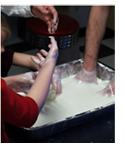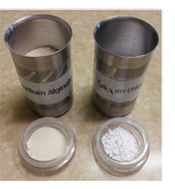Science Can Be Fun - Especially at Halloween!
From Rick McMaster
 Kitchen tested recipes are best — I have done the activities and demos that I describe here many times. What better place to start but with some slime for Halloween? Who can forget Slimer from Ghostbusters? The easiest kind to make is oobleck or cornstarch slime. Oobleck is made up of tiny, solid particles of cornstarch suspended in water, a colloidal suspension. The slime does not obey Newton’s law for fluids; it's a non-Newtonian fluid. In this case, it’s a dilatant material, the higher the shearing force, the higher the viscosity. Kitchen tested recipes are best — I have done the activities and demos that I describe here many times. What better place to start but with some slime for Halloween? Who can forget Slimer from Ghostbusters? The easiest kind to make is oobleck or cornstarch slime. Oobleck is made up of tiny, solid particles of cornstarch suspended in water, a colloidal suspension. The slime does not obey Newton’s law for fluids; it's a non-Newtonian fluid. In this case, it’s a dilatant material, the higher the shearing force, the higher the viscosity.
You’ll need 1 volume measure of cornstarch and about ½ volume measure of water. Pour the cornstarch into a container. Slowly  add the water, just a bit at a time, mixing with your fingers as you go. You’ll know when you have enough. If you squeeze the material it will ball in your fist. When you release the pressure it will drip back into the container. If you do not add food coloring, the mixture will not stain. Just wash any fabrics that are soiled with it as you normally would or vacuum up any that has spilled once it has dried. When you are finished with the slime, don’t dump it down the sink; dispose of it in the trash or in your garden. add the water, just a bit at a time, mixing with your fingers as you go. You’ll know when you have enough. If you squeeze the material it will ball in your fist. When you release the pressure it will drip back into the container. If you do not add food coloring, the mixture will not stain. Just wash any fabrics that are soiled with it as you normally would or vacuum up any that has spilled once it has dried. When you are finished with the slime, don’t dump it down the sink; dispose of it in the trash or in your garden.
Another non-Newtonian fluid is ketchup but it has the opposite property, the higher the shearing force, the lower the viscosity. This is called a psuedoplastic fluid.
 Another simple slime to make is a polymer-based suspension from white glue and a dilute solution of borax. Dissolve 10 grams borax in 250 ml water. Put 30 ml of white glue in a separate container, pour in some of the borax solution and mix with a spoon until you have your putty; then knead it by hand. Food coloring adds interest but increases the potential of staining. Store the putty in a sealable sandwich bag. Make sure that everyone who handles the slim washes their hands and that none of the borax solution is ingested. The science: The white glue is a mixture of water and a polymer. The borate ions from the solution form links, a three dimensional network, among the polymer molecules. With low stress the putty flows; with high stress, it breaks. The science: The white glue is a mixture of water and a polymer. The borate ions from the solution form links, a three dimensional network, among the polymer molecules. With low stress the putty flows; with high stress, it breaks. Another simple slime to make is a polymer-based suspension from white glue and a dilute solution of borax. Dissolve 10 grams borax in 250 ml water. Put 30 ml of white glue in a separate container, pour in some of the borax solution and mix with a spoon until you have your putty; then knead it by hand. Food coloring adds interest but increases the potential of staining. Store the putty in a sealable sandwich bag. Make sure that everyone who handles the slim washes their hands and that none of the borax solution is ingested. The science: The white glue is a mixture of water and a polymer. The borate ions from the solution form links, a three dimensional network, among the polymer molecules. With low stress the putty flows; with high stress, it breaks. The science: The white glue is a mixture of water and a polymer. The borate ions from the solution form links, a three dimensional network, among the polymer molecules. With low stress the putty flows; with high stress, it breaks.
If you prefer your slime transparent, start with 10 grams polyvinyl alcohol (PVA) in 250 ml of water. You will need to heat the mixture to get the PVA to dissolve. After the PVA solution cools, add 15 ml of the same borax solution as above and stir to get your slime. Tinted lime green, this comes close to Slimer. Again, store the slime in a sealable sandwich bag. Make sure that anyone who handles it washes their hands and that none is ingested
Edible worms may not be technically slime but they are lots of fun. Make sure you get food grade chemicals. (My source is the  Modernist Pantry.) Start with 500 ml of water in a blender and add 4 grams of seaweed extract – Sodium Alginate – which is a thickener used in sauces. Be sure that the blender is running as you add the Sodium Alginate. Process to thoroughly mix. Food coloring and flavoring can be added now if you want. Dissolve 2 grams of Calcium Chloride, a salt, in 500 ml of water. To make your worms use a baster to squirt the Sodium Alginate solution into the salt water. Let the “worms” gel for a few minutes, rinse them off in fresh water and pass them around for all to enjoy. Modernist Pantry.) Start with 500 ml of water in a blender and add 4 grams of seaweed extract – Sodium Alginate – which is a thickener used in sauces. Be sure that the blender is running as you add the Sodium Alginate. Process to thoroughly mix. Food coloring and flavoring can be added now if you want. Dissolve 2 grams of Calcium Chloride, a salt, in 500 ml of water. To make your worms use a baster to squirt the Sodium Alginate solution into the salt water. Let the “worms” gel for a few minutes, rinse them off in fresh water and pass them around for all to enjoy.
You can do a lot of Halloween demos with just a little dry ice. First the science and the cautions: Dry ice is CO2 in its solid form. Under normal atmospheric pressure it goes from a solid directly to a gas— it sublimates. It does that at −109.3 °F or −78.5 °C or 194.7K. Because of the extreme cold, great care should be taken in handling dry ice to avoid frostbite; use well insulated gloves or tongs to handle even small pieces. Dry ice should not be kept in a sealed container to avoid the buildup of pressure and potential rupturing of the vessel.
Dry ice is denser than water which allows it to be used for these demos at Halloween
- Add a piece of dry ice to a bowl of hot tap water for instant fog.
- Put the hot water and dry ice inside a carved pumpkin for a seasonal effect.
- Add dish detergent to the bowl of hot water before adding the dry ice and you’ll have a mound of ghost bubbles. The bubbles are harmless but be careful not to reach down into the water and touch the dry ice.
- Add a small piece of dry ice to water or fruit juice in an insulated cup and take a drink as a mad scientist. Try to avoid breathing the high concentration of CO2 above the liquid and never allow the dry ice to touch either your lips or the inside of your mouth.
There are more details on the demos and activities that I’ve briefly described available on various websites. I’ve posted a video showing a few of them.
I have two other things to mention. First, congratulations to the SparkTruck crew who has returned home after nearly four months of generating STEM excitement in their cross country tour. Jason Chua and Eugene Korsunskiy presented at TEDx Manhattan Beach, “Journey to Purpose: Dream. Educate. Thrive.” And Didi’s documentary of the journey should be available in the near future.
Second: This is Engineers Week. It has been and continues to be a catalyst for outreach worldwide for both kids and adults with its wide range of programs. On October 30th, there’s an event open to all, Engineers Week 2013 Countdown Kickoff Webcast. I hope you can join it. I’ll have more on EWeek and outreach in a future column.
As always, your comments are welcome, @drkold.
Rick McMaster is the STEM Advocate at IBM’s University Programs Worldwide.
Back to newsletter |